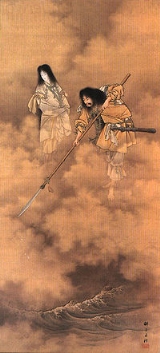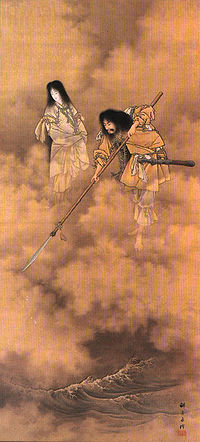
Izanami
Encyclopedia

Japanese mythology
Japanese mythology is a system of beliefs that embraces Shinto and Buddhist traditions as well as agriculturally based folk religion. The Shinto pantheon comprises innumerable kami...
, is a goddess
Goddess
A goddess is a female deity. In some cultures goddesses are associated with Earth, motherhood, love, and the household. In other cultures, goddesses also rule over war, death, and destruction as well as healing....
of both creation and death, as well as the former wife of the god Izanagi
Izanagi
is a deity born of the seven divine generations in Japanese mythology and Shinto, and is also referred to in the roughly translated Kojiki as "male-who-invites" or Izanagi-no-mikoto. It is also pronounced Izanaki-no-Okami....
-no-Mikoto. She is also referred to as Izanami-no-kami.
Goddess of Creation
The first gods KunitokotachiKunitokotachi
In Japanese mythology, is one of the two gods born from "something like a reed that arose from the soil" when the earth was chaotic. In the Nihon Shoki, he is named "Kuni-toko-tachi no mikoto" and is the first of the first three divinities born after heaven and earth were born out of chaos, and...
and Amenominakanushi
Amenominakanushi
In Japanese mythology and Shintoism, Amenominakanushi was the first kami to come into being in the Plain of Heaven as a "solitary kami" . He was acknowledged as one of the zōka sanshin and one of the five kotoamatsukami .Amenominakanushi is found at the very beginning of the Kojiki...
summoned two divine beings into existence, the male
Male
Male refers to the biological sex of an organism, or part of an organism, which produces small mobile gametes, called spermatozoa. Each spermatozoon can fuse with a larger female gamete or ovum, in the process of fertilization...
Izanagi and the female
Female
Female is the sex of an organism, or a part of an organism, which produces non-mobile ova .- Defining characteristics :The ova are defined as the larger gametes in a heterogamous reproduction system, while the smaller, usually motile gamete, the spermatozoon, is produced by the male...
Izanami, and charged them with creating the first land. To help them do this, Izanagi and Izanami were given a spear
Spear
A spear is a pole weapon consisting of a shaft, usually of wood, with a pointed head.The head may be simply the sharpened end of the shaft itself, as is the case with bamboo spears, or it may be made of a more durable material fastened to the shaft, such as flint, obsidian, iron, steel or...
decorated with jewels, named Ame-no-nuboko
Amenonuhoko
is the name given to the naginata in Japanese mythology used to raise the primordial land-mass, Onōgoro-shima, from the sea. According to the Kojiki, the gods Izanagi and Izanami were responsible for creating the first land. To help them do this, they were given a naginata decorated with jewels,...
(heavenly spear). The two deities then went to the bridge between heaven and earth, Ame-no-ukihashi ("floating bridge of heaven"), and churned the sea below with the spear. When drops of salty water fell from the spear, Onogoroshima ("self-forming island") was created. They descended from the bridge of heaven and made their home on the island.
Eventually they wished to be mated, so they built a pillar called Ame-no-mihashira ("pillar of heaven"; the mi- is an honorific prefix) and around it they built a palace called Yahiro-dono (one hiro is approximately 182 cm, so the "eight-hiro-palace" would have been 14.56 m²). Izanagi and Izanami circled the pillar in opposite directions and, when they met on the other side, Izanami spoke first in greeting. Izanagi didn't think that this was the proper thing to do, but they mated anyhow. They had two children, Hiruko ("leech-child") and Awashima ("faint island"), but they were born deformed and are not considered deities.
They put the children into a boat and set them out to sea, then petitioned the other gods for an answer as to what they did wrong. They were told that the male deity should have spoken first in greeting during the marriage ceremony. So Izanagi and Izanami went around the pillar again, this time Izanagi speaking first when they met, and their marriage was finally successful.
From their union were born the ōyashima, or the "great eight islands" of the Japanese chain:
- AwajiAwaji Islandis an island in Hyōgo Prefecture, Japan, in the eastern part of the Seto Inland Sea between the islands of Honshū and Shikoku. The island has an area of 592.17 km²...
- Iyo (later ShikokuShikokuis the smallest and least populous of the four main islands of Japan, located south of Honshū and east of the island of Kyūshū. Its ancient names include Iyo-no-futana-shima , Iyo-shima , and Futana-shima...
) - OgiOki Provincewas an old province of Japan which is now Shimane Prefecture. It was sometimes called . Oki province consisted of the Oki Islands in the Sea of Japan, located off the coast of the provinces of Izumo and Hōki....
- Tsukushi (later KyūshūKyushuis the third largest island of Japan and most southwesterly of its four main islands. Its alternate ancient names include , , and . The historical regional name is referred to Kyushu and its surrounding islands....
) - IkiIki IslandIki Island is an island lying between the island of Kyūshū and the Tsushima islands in the Tsushima Strait, the eastern channel of the Korea Strait. It is currently part of Nagasaki Prefecture of Japan. The city of Iki is the centre of the local government. The island has three ports.The island’s...
- TsushimaTsushima IslandTsushima Island is an island of the Japanese Archipelago situated in the middle of the Tsushima Strait at 34°25'N and 129°20'E. The main island of Tsushima was once a single island, but the island was divided into two in 1671 by the Ōfunakosiseto canal and into three in 1900 by the Manzekiseto canal...
- Sado
- Yamato (later HonshūHonshuis the largest island of Japan. The nation's main island, it is south of Hokkaido across the Tsugaru Strait, north of Shikoku across the Inland Sea, and northeast of Kyushu across the Kanmon Strait...
)
- Note that HokkaidōHokkaido, formerly known as Ezo, Yezo, Yeso, or Yesso, is Japan's second largest island; it is also the largest and northernmost of Japan's 47 prefectural-level subdivisions. The Tsugaru Strait separates Hokkaido from Honshu, although the two islands are connected by the underwater railway Seikan Tunnel...
, Chishima and Okinawa were not part of Japan in ancient times.
They bore six more islands and many deities. Izanami died giving birth to the child Kagu-Tsuchi
Kagu-tsuchi
, also called , , or , is the kami of fire in Japanese mythology.-Mythology:Kagu-tsuchi's birth burned his mother Izanami, causing her death. His father Izanagi, in his grief, beheaded Kagu-tsuchi with his sword, Ame no Ohabari , and cut his body into eight pieces, which became eight volcanoes...
(incarnation of fire) or Ho-Masubi (causer of fire). She was then buried on Mt. Hiba, at the border of the old provinces of Izumo
Izumo Province
was an old province of Japan which today consists of the eastern part of Shimane Prefecture. It was sometimes called . The province is in the Chūgoku Region.- History :It was one of the regions of ancient Japan where major political powers arose...
and Hōki
Hoki Province
was an old province of Japan in the area that is today the western part of Tottori Prefecture. It was sometimes called . Hōki bordered on Inaba, Mimasaka, Bitchū, Bingo, and Izumo Provinces....
, near modern-day Yasugi of Shimane Prefecture
Shimane Prefecture
is a prefecture of Japan located in the Chūgoku region on Honshū island. The capital is Matsue. It is the second least populous prefecture in Japan, after its eastern neighbor Tottori. The prefecture has an area elongated from east to west facing the Chūgoku Mountain Range on the south side and to...
. So angry was Izanagi at the death of his wife that he killed the newborn child, thereby creating dozens of deities.
Izanami in the Kojiki
The Kojiki show some references about Izanami's life, although there's little information and the scriptures aren't quite so specific either.It is believed that Izanami transferred her soul
Soul
A soul in certain spiritual, philosophical, and psychological traditions is the incorporeal essence of a person or living thing or object. Many philosophical and spiritual systems teach that humans have souls, and others teach that all living things and even inanimate objects have souls. The...
inside an animal
Animal
Animals are a major group of multicellular, eukaryotic organisms of the kingdom Animalia or Metazoa. Their body plan eventually becomes fixed as they develop, although some undergo a process of metamorphosis later on in their life. Most animals are motile, meaning they can move spontaneously and...
and a human
Human
Humans are the only living species in the Homo genus...
before her death, although it's unknown whether Izanami had incarnations or not.
Death of Izanami-no-Mikoto
Izanagi-no-Mikoto lamented the death of Izanami-no-Mikoto and undertook a journey to YomiYomi
, the Japanese word for the underworld in which horrible creatures guard the exits; according to Shinto mythology as related in Kojiki, this is where the dead go to dwell and apparently rot indefinitely. Once one has eaten at the hearth of Yomi it is impossible to return to the land of the living...
("the shadowy land of the dead"). Quickly, he searched for Izanami-no-Mikoto and found her. At first, Izanagi-no-Mikoto could not see her at all for the shadows hid her appearance well. Nevertheless, he asked her to return with him. Izanami-no-Mikoto spat out at him, informing Izanagi-no-Mikoto that he was too late. She had already eaten the food of the underworld
Underworld
The Underworld is a region which is thought to be under the surface of the earth in some religions and in mythologies. It could be a place where the souls of the recently departed go, and in some traditions it is identified with Hell or the realm of death...
and was now one with the land of the dead. She could no longer return to the living.
Izanagi-no-Mikoto was shocked at this news but he refused to give in to her wishes of being left to the dark embrace of Yomi. While Izanami-no-Mikoto was sleeping, he took the comb that bound his long hair and set it alight as a torch. Under the sudden burst of light, he saw the horrid form of the once beautiful and graceful Izanami-no-Mikoto. She was now a rotting form of flesh with maggots and foul creatures running over her ravaged body.
Crying out loud, Izanagi-no-Mikoto could no longer control his fear and started to run, intending to return to the living and abandon his death-ridden wife. Izanami-no-Mikoto woke up shrieking and indignant and chased after him. Wild shikome (foul women) also hunted for the frightened Izanagi-no-Mikoto, instructed by Izanami-no-Mikoto to bring him back.
Izanagi-no-Mikoto burst out of the entrance and quickly pushed a boulder in the mouth of the Yomotsuhirasaka (黄泉津平坂; cavern that was the entrance of Yomi). Izanami-no-Mikoto screamed from behind this impenetrable barricade and told Izanagi-no-Mikoto that if he left her she would destroy 1,000 residents of the living every day. He furiously replied he would give life to 1,500.

